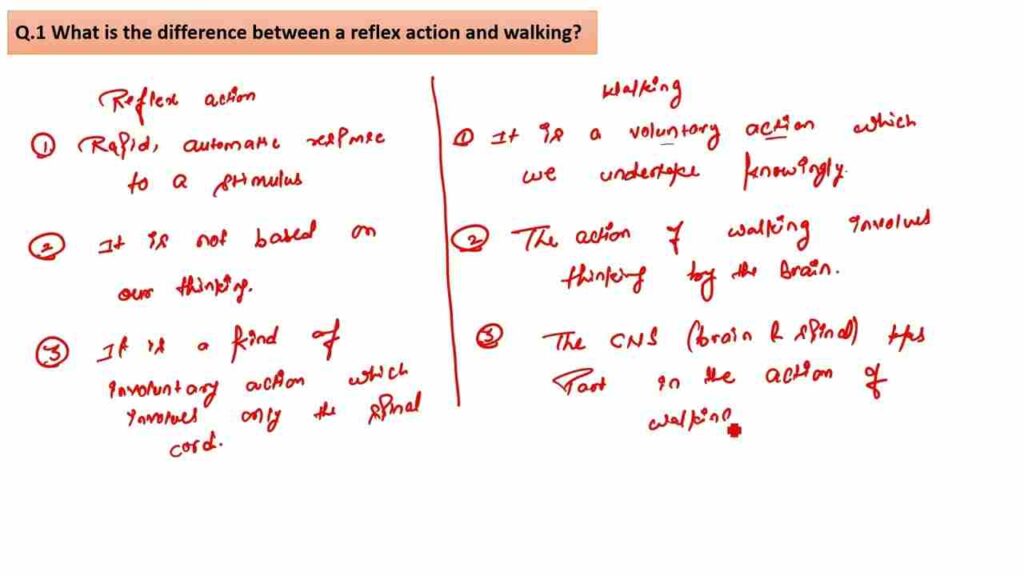
Explore 15 Key Difference between Reflex Action and Walking
Within the realm of human physiology, two fascinating phenomena occur: reflex actions and walking. While both involve the coordination of muscles and nerves, they differ significantly in purpose, mechanism, and outcome. In this exploration, we will highlight the key difference between reflex action and walking, shedding light on their unique characteristics.
Difference between Reflex Action and Walking
Purpose: Reflex actions are quick, automatic responses to specific stimuli, aiming to protect the body from harm. Walking, on the other hand, is a voluntary action performed to move from one place to another.
Initiation: Reflex actions occur involuntarily, bypassing conscious control. In contrast, walking is a consciously initiated action, requiring intentional effort to start.
Complexity: Reflex actions are simpler, involving only a few muscles and a limited number of nerves. Walking, however, is a complex action that requires the coordination of multiple muscle groups and intricate neural pathways.
Integration: Reflex actions primarily occur in the spinal cord or lower brain regions, bypassing higher brain centers. Walking involves the integration of signals from various brain regions, including the cerebrum, cerebellum, and brainstem.
Duration: Reflex actions are brief, providing immediate responses to sudden stimuli. Walking can be sustained for extended periods, allowing for continuous movement.
Voluntariness: Reflex actions are involuntary and often happen without conscious awareness or effort. Walking, on the other hand, is a voluntary action that requires conscious intent and effort.
Learning: Reflex actions are innate and do not involve learning or adaptation. Walking, however, is a learned skill that improves with practice and experience.
Complexity of Movement: Reflex actions involve simple movements, such as pulling away from a hot object or blinking in response to a bright light. Walking requires a more complex sequence of movements, including coordinated leg motions, balance adjustments, and control of multiple muscle groups.
Muscular Control: Reflex actions engage a limited number of muscles for a quick and protective response. Walking involves a wider range of muscles, requiring precise coordination and control for smooth locomotion.
Sensory Input: Reflex actions respond to specific sensory stimuli, triggering predefined responses. Walking incorporates ongoing sensory input, allowing for continuous adjustment and adaptation to the environment.
Effort: Reflex actions require minimal effort, as they are automatic and reflexive. Walking demands physical effort and energy expenditure, particularly during prolonged or strenuous activities.
Cognitive Involvement: Reflex actions are primarily driven by the spinal cord and lower brain centers, with minimal cognitive involvement. Walking involves higher-level cognitive processes, such as planning, decision-making, and spatial awareness.
Adaptability: Reflex actions have limited adaptability and cannot be consciously modified or controlled. Walking allows for adaptive changes in speed, direction, and gait, depending on the circumstances.
Environmental Factors: Reflex actions are triggered by immediate stimuli, regardless of the environment. Walking is influenced by environmental factors like terrain, obstacles, and gravity, requiring continuous adjustments for stability and efficiency.
Developmental Milestones: Reflex actions, such as the sucking reflex in newborns, emerge early in life for survival. Walking typically develops later in infancy or early childhood as a significant motor milestone.
Reflex actions and walking represent distinct phenomena within human physiology. Reflex actions are quick, automatic responses for protection, while walking is a voluntary and complex action for movement. Understanding the Difference between Reflex Action and Walking these two phenomena provides insight into our remarkable capabilities as human beings.
Also Read: Explore 15 key Difference between Physisorption and Chemisorption